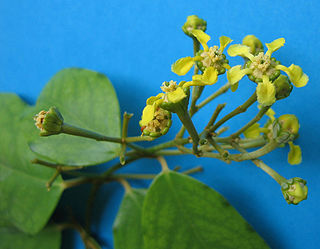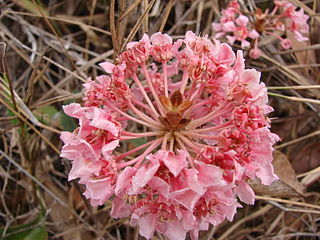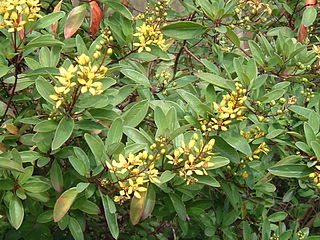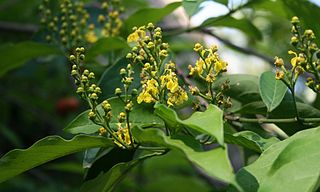Acmanthera is a genus in the Malpighiaceae, a family of about 75 genera of flowering plants in the order Malpighiales. Acmanthera comprises 7 species of trees, shrubs, or subshrubs native to Brazil.

Heteropterys is a genus in the Malpighiaceae, a family of about 75 genera of flowering plants in the order Malpighiales. Heteropterys comprises over 140 species of woody vines, shrubs, and small trees found in the New World tropics and subtropics from northern Mexico and the West Indies to northern Argentina and southeastern Brazil. One widespread, mostly Caribbean species, H. leona, is also found in low wet places along the coast of West Africa from Senegal to Angola.

Pterandra is a genus in the Malpighiaceae, a family of about 75 genera of flowering plants in the order Malpighiales. Pterandra comprises 15 species of trees, shrubs, and subshrubs, all but two native to South America, principally Colombia, Venezuela, and Brazil; the exceptions are from Panama. There are only some ornamental plants introduced in China, and there are no native varieties.

Rupert Charles Barneby was a British-born self-taught botanist whose primary specialty was the Fabaceae (Leguminosae), the pea family, but he also worked on Menispermaceae and numerous other groups. He was employed by the New York Botanical Garden from the 1950s until shortly before his death.
Barnebya is a genus in the Malpighiaceae, a family of about 75 genera of flowering plants in the order Malpighiales. Barnebya comprises 2 species of trees and woody vines native to eastern Brazil. The genus is named in honor of the American botanist Rupert Charles Barneby (1911–2006).
Peixotoa is a genus in the Malpighiaceae, a family of about 75 genera of flowering plants in the order Malpighiales. Peixotoa comprises 29 species of vines, shrubs, and subshrubs native to Brazil and adjacent Paraguay and Bolivia.
Thryallis is a genus in the family Malpighiaceae, of scandent shrubs and woody vines native to Brazil and adjacent Paraguay and Bolivia.

Galphimia is a genus in the Malpighiaceae, a family of about 75 genera of flowering plants in the order Malpighiales; the name is an anagram of Malpighia.Galphimia comprises 26 species of large herbs, shrubs, and treelets. Twenty-two species occur in Mexico, one extending into Texas and one ranging to Nicaragua; four species occur in South America, south of the Amazon Basin. Galphimia gracilis is widely cultivated in warm regions throughout the world. Eight species are distinctive in that the petals become stiff and papery, and persist past the stage of fruit maturation.

Bunchosia is a genus in the Malpighiaceae, a family of about 75 genera of flowering plants in the order Malpighiales. It contains roughly 75 species of trees and shrubs, which are native to dry woodlands, savannas, and wet forests. Their range extends from Mexico and the Caribbean to southeastern Brazil and adjacent Argentina. Bunchosia is one of three arborescent genera of Malpighiaceae with fleshy, bird-dispersed fruits.

Hiraea is a genus in the Malpighiaceae, a family of about 75 genera of flowering plants in the order Malpighiales. Hiraea comprises over 55 species of woody vines and shrubs found in diverse habitats, except very dry vegetation types, in the New World tropics and subtropics from western Mexico to Paraguay and adjacent Argentina and southeastern Brazil; it also occurs in the Lesser Antilles in Grenada and St. Lucia.

Mascagnia is a genus in the Malpighiaceae, a family of about 75 genera of flowering plants in the order Malpighiales. The genus Mascagnia comprises about 45 species that occur in diverse habitats from northern Mexico and the Caribbean to northern Argentina and south-eastern Brazil.

Stigmaphyllon is a genus in the Malpighiaceae, a family of about 75 genera of flowering plants in the order Malpighiales. Amazonvine is a common name for species in this genus.
Coleostachys is a genus in the Malpighiaceae, a family of about 75 genera of flowering plants in the order Malpighiales. Coleostachys contains only one species of shrubs or treelets found in wet forests of the Amazonian lowlands of French Guiana and adjacent Brazil.
Diacidia is a genus in the Malpighiaceae, a family of about 75 genera of flowering plants in the order Malpighiales. Diacidia comprises 11 species of trees, shrubs, and subshrubs. Ten species are found on the mountains of southern Venezuela and adjacent Brazil; one species is widespread in the drainages of the Rio Negro and the Río Vaupés in Venezuela, Colombia, and Brazil.
Glandonia is a genus in the Malpighiaceae, a family of about 75 genera of flowering plants in the order Malpighiales. Glandonia comprises 3 species of trees or shrubs native to lowland forests along rivers or in areas periodically flooded in Amazonian Colombia, Venezuela, and Brazil.
Blepharandra is a genus in the Malpighiaceae, a family of about 75 genera of flowering plants in the order Malpighiales. Blepharandra comprises 6 species of trees and shrubs native to sandy savannas and scrub forests of Guyana, southern Venezuela, and Amazonian Brazil.
Rogers McVaugh was a research professor of botany and the UNC Herbarium's curator of Mexican plants. He was also Adjunct Research Scientist of the Hunt Institute in Carnegie Mellon University and a Professor Emeritus of botany in the University of Michigan, Ann Arbor.
Heladena is a genus in the Malpighiaceae, a family of about 75 genera of flowering plants in the order Malpighiales. Heladena includes one species, Heladena multiflora, a woody vine or sometimes a shrub or small tree native to gallery forests and woodlands of southern Brazil, Paraguay, and northeastern Argentina.
Burdachia is a genus in the Malpighiaceae, a family of about 75 genera of flowering plants in the order Malpighiales. Burdachia comprises 3 species of trees and shrubs occurring in lowland forests near rivers or in low, periodically flooded places in Guyana and Amazonian Venezuela, Colombia, Brazil, and Peru.
Dicella is a genus in the Malpighiaceae, a family of about 75 genera of flowering plants in the order Malpighiales. Dicella includes seven species, assigned to two sections. Section Dicella comprises D. bracteosa and D. nucifera, found in southeastern Brazil and adjacent Paraguay and Argentina. Section Macropterys includes D. aciculifera, known only from Costa Rica, and D. conwayi, D. julianii, D. macroptera, and D. oliveirae, all of South America from Colombia south to about 19°S







